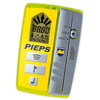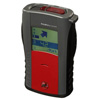![]()
These days, there are many more avalanche beacons (transceivers) to choose from than a decade ago. Avalanche beacons differ in how much they are selling for, in technologies they use, and obviously in manufacturers that make them.
Here are tips that will help you to choose the right avalanche beacon by:
- briefly explaining the different types of avalanche beacon technologies
- defining what kind of a user you are, or whomever you are purchasing the beacon for
The latest avalanche beacons are definitely better but it’s confusing for buyers to choose the one that fits their abilities the best.
6 most popular beacons (after 2011/12 season):
Avalanche beacons compatibility
 It seems that one basic piece of information is not communicated by the manufacturers and professionals clearly enough because many people wonder about compatibility of different types of avalanche transceivers and between manufacturers.
It seems that one basic piece of information is not communicated by the manufacturers and professionals clearly enough because many people wonder about compatibility of different types of avalanche transceivers and between manufacturers.
The only thing you need to know is that all avalanche beacons operate on the same frequency (457 kHz) and are therefore fully compatible. That means you can search for any avalanche beacon with any other avalanche beacon on the market.
There might be some fancy features that are only shared within a certain model type but the core practical functionality of all beacons is compatible as it was agreed by all manufacturers long time ago.
Avalanche beacon technologies: understanding different types
Basically, there are three types of avalanche beacons on the market today:
- Analogue
- Digital
- Analogue/digital (hybrid)
Analogue avalanche beacons
 The analogue avalanche beacons are almost out of the market by now but they are the ones that started it all.
The analogue avalanche beacons are almost out of the market by now but they are the ones that started it all.
Bottom line: Analogue avalanche beacons, generally, have a big search range and are great for picking up a signal from further distance. However, they require quite a bit of practice for a novice or not too experienced users to be efficient with. But if you practice a lot you can become very good in searching with them. They are in the lowest price range of all avalanche beacons.
Digital avalanche beacons
 Digital avalanche beacons came to the market around 2001. Their main aim was to cut searching times by providing a user with a computer-like beacon. Every digital avalanche beacon has a micro-processor, just like computers do, that filters data for the user and communicates them through distance numbers and direction arrows.
Digital avalanche beacons came to the market around 2001. Their main aim was to cut searching times by providing a user with a computer-like beacon. Every digital avalanche beacon has a micro-processor, just like computers do, that filters data for the user and communicates them through distance numbers and direction arrows.
Bottom line: Digital avalanche beacons are easier to use (to search with) than the previous analogue technology which makes them a great choice for any type of users. However, some are more suitable for professionals than less experienced users.
Digital beacons have a smaller range than analogue beacons but the micro-processor capabilities can greatly compensate for inexperience thus cutting down the search times. The prices for digital avalanche beacons vary greatly depending on their features, performance and manufacturer.
Analogue/digital avalanche beacons
These avalanche beacons use both of the above technologies, however, they don’t seem to provide any significant advantage over the digital beacons. And there are only one or two models of this type of beacons currently on the market, which suggests manufacturers are rather betting (and working) on the full digital platform than sticking with older technology.
Bottom line: These hybrid beacons are like enhanced analogue avalanche beacons and are as good as some fully digital beacons, however, there doesn’t seem to be much need for this type of beacons. They are being pretty much phased out just like the analogue beacons. Digital is the way. Prices are comparable to lower priced digital beacons.
Avalanche beacon user groups
Here is a brief differentiation of avalanche beacon users based on their experience. This might not be the best groups’ definition there is, however, it reflects how people usually define themselves when shopping for an avalanche beacon:
Novice
- used an avalanche beacon very few times in their life if at all
- no experience with multiple burials
- accessing backcountry mostly from a lift to do individual runs
Regular
- uses an avalanche beacon couple of times a year
- some experience with multiple burials
- quite proficient with their current beacon
- regularly travels in backcountry
Advanced/Professional
- lots of practice and experience with different types of avalanche beacons in many different scenarios
- very frequent users, mountain guides, ski patrol, rescue professionals, etc.
Suitable avalanche beacon models based on a user group and beacon type
Analogue avalanche beacons – more suitable for (very) experienced users, however, even they are now switching to digital technology.
Digital beacons – this is the future of the industry and every user group can find a model within this technology.
Hybrid – they are a good alternative and more suitable for the novice and regular users.
Specific avalanche beacon models suitability
Novice:
- Backcountry Access Tracker 2
- Ortovox 3+
- Backcountry Access Tracker DTS
- Ortovox Patroller Digital
- Pieps DSP (may seem little overwhelming for some novice users)
- Pieps Freeride (for those that access backcountry from a lift for individual runs)
- Mammut Pulse Barryvox (may seem little overwhelming for some novice users)
Regular:
- Backcountry Access Tracker 2
- Ortovox S1+
- Backcountry Access Tracker DTS
- Mammut Pulse
- Ortovox 3+
- Pieps DSP
- Ortovox F1 (if willing to practice regularly)
- Ortovox Patroller Digital
- Ortovox S1
Advanced/Professional:
This type of a user should know what beacon he wants and that suits him the best. But here are some suggested options since this user group should be well equipped to take full advantage of the most advanced features in avalanche beacon technology.
- Ortovox S1+
- Pieps DSP
- Mammut Pulse
- Backcountry Access Tracker 2 (more affordable but not as advanced)
- Ortovox 3+ (more affordable but not as advanced)
- Ortovox S1
Avalanche beacons by technology
Here is a list of specific avalanche beacons based on which technology they use and that are currently available on the market.
Analogue:
Digital:
- Backcountry Access Tracker 2
- Backcountry Access Tracker DTS
- Mammut Pulse
- Ortovox S1+
- Ortovox 3+
- Ortovox Patroller Digital
- Pieps DSP
- Pieps FreeRide
- Ortovox S1
Analogue/Digital:
- Ortovox M2 (discontinued)
Practice your avalanche beacon search
No matter which avalanche beacon you buy there is no substitute for practice. Yes, some are easier to use than others but each one behaves slightly different and it is best if you get to know your avalanche beacon intimately through practice.
